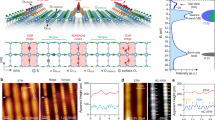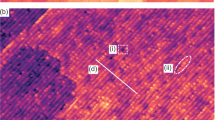Abstract
Oxide surfaces are important for applications in catalysis and thin film growth. An important frontier in solid-state inorganic chemistry is the prediction of the surface structure of an oxide. Comparatively little is known about atomic arrangements at oxide surfaces at present, and there has been considerable discussion concerning the forces that control such arrangements. For instance, one model suggests that the dominant factor is a reduction of Coulomb forces1; another favours minimization of ‘dangling bonds’ by charge transfer to states below the Fermi energy2. The surface structure and properties of SrTiO3—a standard model for oxides with a perovskite structure—have been studied extensively3,4,5,6,7,8,9,10,11,12,13,14. Here we report a solution of the 2 × 1 SrTiO3 (001) surface structure obtained through a combination of high-resolution electron microscopy and theoretical direct methods. Our results indicate that surface rearrangement of TiO6-x units into edge-sharing blocks determines the SrO-deficient surface structure of SrTiO3. We suggest that this structural concept can be extended to perovskite surfaces in general.
This is a preview of subscription content, access via your institution
Access options
Subscribe to this journal
Receive 51 print issues and online access
$199.00 per year
only $3.90 per issue
Buy this article
- Purchase on Springer Link
- Instant access to full article PDF
Prices may be subject to local taxes which are calculated during checkout




Similar content being viewed by others
References
Wolf, D. Reconstruction of NaCl surfaces from a dipolar solution to the Madelung problem. Phys. Rev. Lett. 68, 3315–3318 (1992)
Pashley, M. D. Electron counting model and its application to island structures on molecular-beam epitaxy grown GaAs(001) and ZnSe(001). Phys. Rev. B 40, 10481–10487 (1998)
Kawasaki, M. et al. Atomic control of the SrTiO3 crystal-surface. Science 266, 1540–1542 (1994)
Cord, B. & Courths, R. Electronic study of SrTiO3 surfaces by photoemission. Surf. Sci. 162, 34–38 (1985)
Jiang, Q. D. & Zegenhagen, J. c(6 × 2) and c(4 × 2) reconstruction of SrTiO3 (001). Surf. Sci. 425, 343–354 (1999)
Naito, M. & Sato, H. Reflection high-energy electron diffraction study on the SrTiO3 surface structure. Physica C 229, 1–11 (1994)
Jiang, Q. D. & Zegenhagen, J. SrTiO3 (001)-c(6 × 2): A long-range, atomically ordered surface stable in oxygen and ambient air. Surf. Sci. 367, L42–L46 (1996)
Nishimura, T., Ikeda, A., Namba, H., Morishita, T. & Kido, S. Structure change of TiO2-terminated SrTiO3 (001) surfaces by annealing in O2 atmosphere and ultra-high vacuum. Surf. Sci. 421, 273–278 (1999)
Liang, Y. & Bonnell, D. A. Atomic structures of reduced SrTiO3 (001) surfaces. Surf. Sci. Lett. 285, L510–L516 (1993)
Matsumoto, T., Tanaka, H., Kawai, T. & Kawai, S. STM-imaging of a SrTiO3 (100) surface with atomic-scale resolution. Surf. Sci. 278, L153–L158 (1992)
Szot, K. & Speier, W. Surfaces of reduced and oxidized SrTiO3 from atomic force microscopy. Phys. Rev. B 60, 5909–5926 (1999)
Padilla, J. & Vanderbilt, D. Ab initio study of SrTiO3 . Surf. Sci. 418, 64–70 (1998)
Aruta, C. Structure of superconducting [BaCuOx]2/[CaCuO2]n superlattices on SrTiO3 (001) investigated by X-ray scattering. Phys. Status Solidi A 183, 353–364 (2001)
Droopard, R. et al. Development of high dielectric constant epitaxial oxides on silicon by molecular beam epitaxy. Mater. Sci. Eng. B 87, 292–296 (2001)
Marks, L. D. et al. Direct methods for surfaces. Surf. Rev. Lett. 5, 1087–1106 (1998)
Marks, L. D., Erdman, N. & Subramanian, A. Crystallographic direct methods for surfaces. J. Phys. Condens. Matter 13, 10677–10688 (2001)
Collazo-Davila, C., Grozea, D. & Marks, L. D. Determination and refinement of the Ag/Si(111)-(3 × 1) surface structure. Phys. Rev. Lett. 80, 1678–1681 (1998)
Marks, L. D., Sinkler, W. & Landree, E. A feasible set approach to the crystallographic phase problem. Acta Cryst. 55, 601–612 (1999)
Xu, P. & Marks, L. D. Intensities of surface diffraction spots in plan view. Ultramicroscopy 45, 155–157 (1992)
Collazo-Davila, C. et al. Design and initial performance of an ultrahigh vacuum Sample Preparation Evaluation Analysis and Reaction (SPEAR) system. J. Microsc. Soc. Am. 1, 267–279 (1995)
Marks, L. D. Wiener-filter enhancement of noisy HREM images. Ultramicroscopy 62, 43–52 (1996)
Marks, L. D. & Plass, R. Atomic-structure of Si(111)-(5 × 2)-Au from high resolution electron microscopy and heavy-atom holography. Phys. Rev. Lett. 75, 2172–2175 (1995)
Bengu, E. et al. Imaging the dimers in Si(111)-(7 × 7). Phys. Rev. Lett. 77, 4226–4228 (1996)
Kresse, G. & Hafner, J. Ab-initio molecular dynamics for liquid metals. Phys. Rev. B 47, 558–561 (1993)
Kresse, G. & Furthmuller, J. Efficient iterative schemes for ab initio total-energy calculations using a plane-wave basis set. Phys. Rev. B 54, 11169–11186 (1996)
Vanderbilt, D. Soft self-consistent pseudopotentials in a generalized eigenvalue problem. Phys. Rev. B 41, 7892–7895 (1990)
Perdew, J. P. in Electronic Structure of Solids '91 (eds Ziesche, P. & Eschrig, H.) 11 (Akademie, Berlin, 1991)
Warschkow, O., Dyke, J. M. & Ellis, D. E. A divide-and-conquer implementation of the discrete variational DFT method for large molecular and solid systems. J. Comp. Phys. 143, 70–89 (1998)
Jayaram, G., Xu, P. & Marks, L. D. Atomic structure of the Si (001) 2 × 1 surface. Phys. Rev. Lett. 71, 3489–3492 (1993)
Xu, P., Jayaram, G. & Marks, L. D. Cross-correlation method for intensity measurement of transmission electron-diffraction patterns. Ultramicroscopy 53, 15–18 (1994)
Acknowledgements
HREM analysis was carried out at the Electron Microscopy Collaborative Research Center at Argonne National Laboratory. This work was supported by the EMSI program of the National Science Foundation and the US Department of Energy Office of Science at the Northwestern University Institute for Environmental Catalysis. M.A. acknowledges funding from the National Science Foundation.
Author information
Authors and Affiliations
Corresponding author
Ethics declarations
Competing interests
The authors declare that they have no competing financial interests.
Supplementary information
Rights and permissions
About this article
Cite this article
Erdman, N., Poeppelmeier, K., Asta, M. et al. The structure and chemistry of the TiO2-rich surface of SrTiO3 (001). Nature 419, 55–58 (2002). https://doi.org/10.1038/nature01010
Received:
Accepted:
Issue Date:
DOI: https://doi.org/10.1038/nature01010
This article is cited by
-
Anomalous intense coherent secondary photoemission from a perovskite oxide
Nature (2023)
-
Identifying s-wave pairing symmetry in single-layer FeSe from topologically trivial edge states
Nature Communications (2023)
-
Machine-learning-accelerated simulations to enable automatic surface reconstruction
Nature Computational Science (2023)
-
Ab initio calculations of CaZrO3 (011) surfaces: systematic trends in polar (011) surface calculations of ABO3 perovskites
Journal of Materials Science (2020)
-
Current channeling along extended defects during electroreduction of SrTiO3
Scientific Reports (2019)
Comments
By submitting a comment you agree to abide by our Terms and Community Guidelines. If you find something abusive or that does not comply with our terms or guidelines please flag it as inappropriate.



